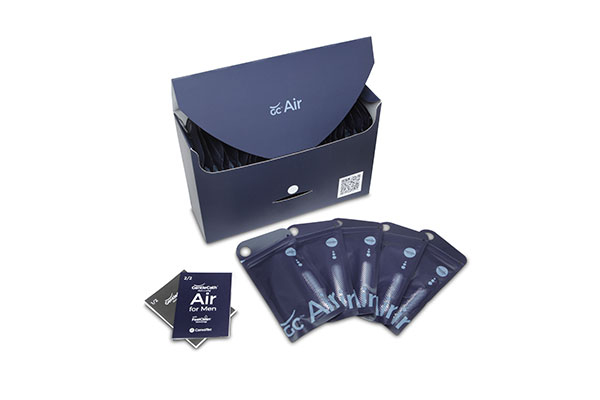

Intermittent catheters shouldn’t be sticky, uncomfortable or messy. Discover FeelCleanTM Technology for a more comfortable user experience.
The experience of performing self-catheterisation, while straightforward for some, can be both difficult and painful for others (Guinet-Lacoste et al, 2016).
40% of study participants said “I have pain (the catheterisation is painful)” (Roberson et al, 2021).
31% of people using hydrophilic coated catheters had blood in their urine (Rognoni and Tarricone, 2017).
Over the years, various strategies have been explored to reduce trauma to the urethra, including external gel lubrication (Wyndaele JJ et al, 1990) and subsequently hydrophilic-coated catheters (Waller L et al, 1995). However, meta-analysis of studies examining hydrophilic-coated catheters still showed that 31% of patients using hydrophilic-coated catheters had blood in their urine, potentially a higher rate than in uncoated catheters (Rognoni C et al, 2017). While hydrophilic-coated catheters improve ease of insertion, during withdrawal, adherence or ‘stickiness’ of catheters to the lining of the urethra has been demonstrated (Fader M et al, 2001). The hydrophilic coating transforms from being highly lubricious when fully wet to being adhesive when the hydration level of the coating is reduced (Bager K et al, 2020). This effect may contribute in part to both the ‘stickiness’ during handling of hydrophilic-coated catheters and also the trauma or bleeding from the urethra with risks increasing the longer the duration of catheterisation (Lundgren J et al, 2000).
To address these issues, Convatec have launched the GentleCathTM range of catheters, which incorporate pioneering FeelCleanTM Technology.
GentleCathTM catheters with FeelCleanTM Technology use a next-generation material that is intrinsically slippery when wet but without the need for a coating. They have low levels of friction during insertion and do not become sticky when removed thereby reducing the risk of trauma or bleeding and the pain this can cause (in vitro data, on file).
90% of users rated GentleCathTM with FeelCleanTM Technology better than their usual catheter for comfort (Convatec, 2018).
Without a coating, GentleCathTM catheters create minimal mess and leave behind less residue than other catheters (in vitro data, on file). So users can feel clean inside and out, all day.
Alison Hodgson has multiple sclerosis and is a GentleCathTM user.
“I have tried several different catheters. With other catheters, the hydrophilic lubricant is sticky and I found that when withdrawing the catheter, it left a residue in my urethra and I was getting UTIs. When I discovered GentleCath catheters, I cried. There is a little sachet of water with the GentleCath Glide catheter, which activates the hydrophilic properties integrated in the catheter to make it slippery. This means that it doesn’t have a sticky coating. I have been using GentleCath for 18 months now and my infections have significantly decreased.”
The GentleCathTM Intermittent Catheter Range

GentleCathTM Glide for Men and Women

GentleCathTM Air for Men

GentleCathTM Air for Women
Intermittent catheter users deserve more than sticky, uncomfortable and messy cathing.
No sticking, minimal mess and residue and game-changing relief (in vitro data, on file).
References
Bager K, Thingbak FSW (Coloplast) (2020) A urinary catheter. (WIPO (PCT) Patent No. WO2020160738). World Intellectual Property Organization.
Convatec (2018) A Multi-Centre Clinical Investigation to Assess the Performance of GentleCathTM Glide Intermittent Catheters. Study U378 GentleCathTM Glide Final Report. July 2018. Data on File. ConvaTec Inc.
Fader M (2001) Coated catheters for intermittent catheterization: smooth or sticky? BJU International; 884: 373-7.
Guinet-Lacoste A et al (2016) Intermittent catheterization diffculty questionnaire (ICDQ): A new tool for the evaluation of patient difficulties with clean intermittent self-catheterization. Neurourology and Urodynamics; 35: 1, 85-9.
Lundgren J et al (2000) The importance of osmolality for intermittent catheterization of the urethra. Spinal Cord; 38: 1, 45-50.
Perrouin-Verbe B et al (1995) Clean intermittent catheterisation from the acute period in spinal cord injury patients. Long term evaluation of urethral and genital tolerance. Paraplegia 33: 619-624.
Roberson D et al (2021) Results of the patient report of intermittent catheterization experience (price) study. Neurourology and Urodynamics; 40: 8, 2008-2019.
Rognoni C, Tarricone R (2017) Intermittent catheterisation with hydrophilic and non-hydrophilic urinary catheters: systematic literature review and meta-analyses. BMC Urology; 17: 1, 4.
Waller L et al (1995) Clean intermittent catheterization in spinal cord injury patients: long-term followup of a hydrophilic low friction technique. Journal of Urology; 153: 2, 345-8.
Wyndaele JJ, Maes D (1990) Clean intermittent self-catheterization: a 12-year followup. Journal of Urology; 143: 5, 906-8.
WHRI6933 TA 1369 FeelClean Phase 1 Report. WHRI7131 TA 1486 v2.